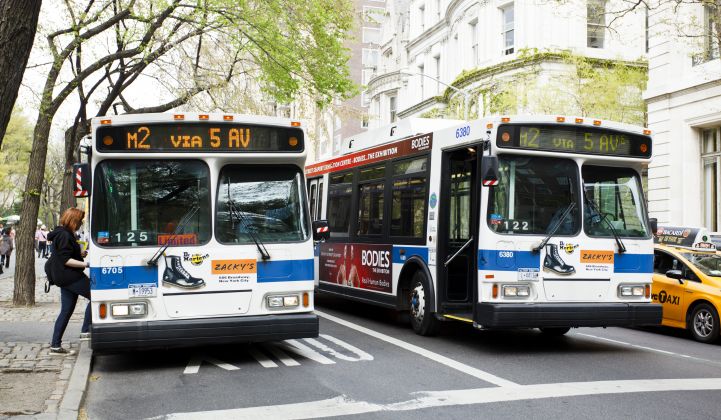The U.S. government is issuing $55 million in federal grants to fund four dozen projects that will replace aging internal-combustion buses with efficient, cleaner transportation.
Zero-emission technologies are maturing in transportation, and taxpayer-backed projects across 39 states are helping to kick-start greener mass transit. Migration toward electric buses is picking up speed, partly due to longer-lasting batteries and growing awareness of climate change.
Now, transit providers and the communities they serve face challenges (at times pressures) to creatively finance the growth of electric fleets, charging stations, electricity grid upgrades and other infrastructure that keep the wheels turning.
The federal funds help transit providers launch or accelerate their vehicle and infrastructure programs even in the face of budget constraints or competing interests. Market growth in zero-emission technologies is fanned by growing public awareness of the new options that provide cleaner air, a better experience for passengers and drivers, and increasingly, an imperative to cut greenhouse gas emissions.
The federal funds and projects acknowledge that electrification is primed to move beyond the combustion vehicles that contribute heavily to transportation pollution in cities. New grants administered by the U.S. Department of Transportation’s Federal Transit Administration (FTA) add to the funding endorsement of several states, including California and New York, for electrification in the transit space.
“As transit providers nationwide face a backlog of maintenance needs, it is imperative to replace aging buses near the end of their useful life with newer, cleaner models that are also more efficient to operate and maintain,” K. Jane Williams, the FTA’s acting administrator, said in announcing the grants.
The shifting attention toward electrified mass transit is the latest sign that electric vehicles -- from passenger cars to metro buses to enterprise fleets -- are grabbing growing mindshare.
Governors in seven Western states -- Colorado, Idaho, Montana, Nevada, New Mexico, Utah and Wyoming -- announced their aspirations of outfitting more than 5,000 miles of highways with a network of fast-charging stations for EVs. This initiative is intended to ease range anxiety by shortening the distance between charging spots along major corridors.
Transportation accounts for more than one-quarter of this nation’s greenhouse gas emissions, according to the U.S. Environmental Protection Agency. In a country with more than 70,000 transit vehicles -- and with buses averaging roughly 34,000 miles of travel each year -- electrification of the U.S. fleet and mass transportation sectors is becoming a top priority for city officials and utilities as they reimagine how people and goods move sustainably across urban landscapes.
Removing fossil fuels from mass transit will go far in reducing that carbon footprint.
Los Angeles County viewed itself as ahead of the game six years ago, when its transit authority -- the nation’s second-biggest -- retired the last of its fleet’s diesel buses and transitioned fully to alternative fuels, including cleaner-burning compressed natural gas.
The mission: reduce air pollution in one of the nation’s smoggiest regions. The region’s governing transportation authority agreed to invest more than $138 million for 95 electric buses -- the first step toward eliminating tailpipe emissions from its more than 2,300 buses by 2030. These moves put L.A. Metro on a growing list of agencies committing to 100 percent electric fleets, further building momentum for the market.
Meanwhile, the technology keeps advancing. California-based Proterra, beneficiary of many of the FTA projects getting federal grants, announced that one of its 40-foot battery-powered buses went 1,101 miles on a single charge, beating last year’s best distance of 603 miles. By Proterra’s definition, this is a new record.
Adoption interest is growing, and this evolution presents new challenges.
Electrified mass transit has significant charging demand, and cities must determine how to scale charging infrastructure and manage increased electric loads. Enabling a robust EV charging infrastructure for passenger vehicles requires industry, municipal and utility partnerships.
Public transit agencies and utilities must develop infrastructure road maps to guide pilots and mass deployment for on-route and depot charging scenarios. The battery charging demands of large buses -- and fleets of those buses -- will create substantial loads for the grid that could necessitate distribution grid upgrades.
These capital-intensive upgrades require careful coordination with the host utility and have long lead times for engineering, permitting and construction. Utilities and cities should begin preparations now to design, finance and manage this new infrastructure.
Electric buses are growing in number, moving people in cleaner, greener ways. Government grants help seed the necessary first steps of electrification, though it likely will present fresh challenges over how cities can comfortably scale their infrastructure to accommodate electrified mass transit.
With continued adoption and infrastructure development, cities will build sustainable transportation that’s more efficient with a lower total cost of service.
***
Paul Stith is a Solution Lead for Black & Veatch’s Transformative Technologies business, specializing in sustainable transportation and energy storage solutions.



